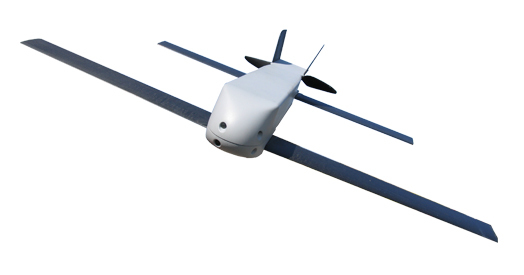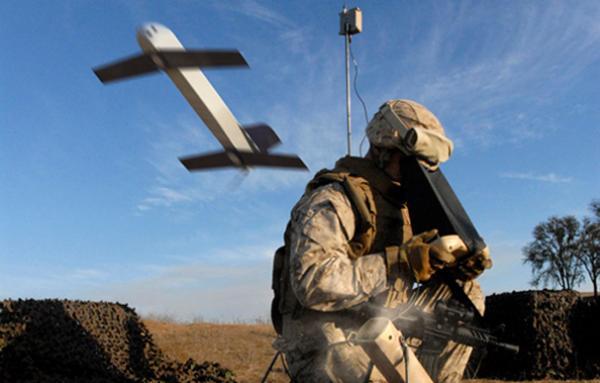By David Crane
defrev (at) gmail (dot) com
October 21, 2011
Last edited/updated on 10/24/11.
 DefenseReview (DR) is a big fan of armed/weaponized UAS/UAVs (Unmanned Aircraft System/Unmanned Aerial Vehicles)/"drones", due to their precision, efficiency, and effectiveness against the enemy, both physically and psychologically. Understand that weaponized unmanned aerial/aircraft systems don't just kill the enemy. They also instill a high degree of fear and uncertainty in the enemy's mind, since the enemy usually can't see or hear the instrument of their destruction until said destruction rains down upon them and removes them from existence, obliterating their body(or bodies, plural) and removing their conciousness from the physical world, releasing it into the quantum universe. Those that survive the attack can't help but be signficantly impacted psychologically from the experience, especially if the targeted individual (or individuals, plural) is a high-value target and/or a friend of theirs and they witness the execution first-hand.
DefenseReview (DR) is a big fan of armed/weaponized UAS/UAVs (Unmanned Aircraft System/Unmanned Aerial Vehicles)/"drones", due to their precision, efficiency, and effectiveness against the enemy, both physically and psychologically. Understand that weaponized unmanned aerial/aircraft systems don't just kill the enemy. They also instill a high degree of fear and uncertainty in the enemy's mind, since the enemy usually can't see or hear the instrument of their destruction until said destruction rains down upon them and removes them from existence, obliterating their body(or bodies, plural) and removing their conciousness from the physical world, releasing it into the quantum universe. Those that survive the attack can't help but be signficantly impacted psychologically from the experience, especially if the targeted individual (or individuals, plural) is a high-value target and/or a friend of theirs and they witness the execution first-hand.
In the past, I've stated that weaponized UAS/UAVs represent telepresence taken to its ultimate conclusion. As such, they represent the yang to remote surgery's/telesurgery's yin, in that regard. While telesurgery uses telepresence to repair and ultimately heal the body, armed drones use it to destroy/kill the body, the latter an act that can ironically be every bit as beneficial to the world. After all, there are some pretty dangerous and destructive people out there that need killing, and their deaths can save many innocent people's lives.
However, if I'm being honest (which I try to be most of the time), I'm not sure that the sanitized, remote-controlled precision destruction/killing afforded by armed drone aircraft is necessarily a a psychologically and karmically "healthy" method of warfare, since it removes warfare's core danger and historically very personal, intimate aspects, which have always acted as war's greatest deterrents. Remote warfare is therefore, in a way, even more dangerous and sinister than the most primitive up-close-and-personal warfare methods.
Historically, in traditional warfare, soldiers have had to actively place themselves in grave physical danger and tremendous hardship, and usually experience the fear of death in order to perform the grim task of killing the enemy. Even if they've already become numb to killing and fear of death, as one often hears from veterans recounting their epic and sometimes historic battles in World War II (WWII) and Vietnam, the bottom line is they at least know they can die and actually experience warfare viscerally. Remote robotic warfare removes the crucial physical danger, fear and hardship elements from the equation and creates a remote isolating barrier along with a psychological and experiential detachment. Killing up close in a QCB/CQC (Close Quarters Battle/Close Quarters Combat) is a very personal and potentially blood curdling experience, and the comeraderie/brotherhood that results from men fighting and killing side-by-side can create profound intimacy between human beings. These are both important warfare experiences. Remote warfare therefore dehumanizes and sanitizes the killing process, turning it into more of a sterile, video game-like experience, the only difference being that the opposing forces you're killing are actual human beings located up to thousands of miles away (while still being killed in real time), rather than electronic representations of human beings generated by your PlayStation or Xbox.
On the plus side, though, instead of just achieving a high score, in remote warfare, you get to actually make the world a better place to live, and perhaps even save it. You also get to save your friends and fellow combatants. While some might argue that you're killing your soul one bad guy at a time, you're certainly maximizing your and your fellow soldier's physcial safety and chances of survival. However, again on the negative side, with enough high technology weapons and money supply, a nation state can conceivably engage in endless warfare, since the historic deterrents to warfare (visible gruesome human slaughter, fear, hardship) no longer exist for it. Just something to consider. There's actually an episode of Star Trek: The Original Series (TOS) (Season 1) called "A Taste of Armageddon" that takes this psychological/experiential detachment danger to its ultimate logical conclusion and shows its dangers.
 Which brings us around to the topic of this article: the AeroVironment (AV) Switchblade SUAV (Small Unmanned Aircraft System)/mini-UAS "kamikaze drone", which is essentially a tube-launched small, slow-moving mini-flying bomb/precision-guided missile that will soon be going into U.S. Army service in a tactical reconnaissance/lethal combat role rather than just a tactical recon role. Defense Review really likes this concept, as well as its precision aspect when practically applied. Finally, this is a kamikaze concept Americans can really get behind, since it doen't result in the loss of the pilot. After all, we don't have an emperoror for whom we're willing to die.
Which brings us around to the topic of this article: the AeroVironment (AV) Switchblade SUAV (Small Unmanned Aircraft System)/mini-UAS "kamikaze drone", which is essentially a tube-launched small, slow-moving mini-flying bomb/precision-guided missile that will soon be going into U.S. Army service in a tactical reconnaissance/lethal combat role rather than just a tactical recon role. Defense Review really likes this concept, as well as its precision aspect when practically applied. Finally, this is a kamikaze concept Americans can really get behind, since it doen't result in the loss of the pilot. After all, we don't have an emperoror for whom we're willing to die.
The following information comes directly from the AeroVironment (AV) website:
The Switchblade is designed to provide the warfighter with a “magic bullet”. It can rapidly provide a powerful, but expendable miniature flying Intelligence, Surveillance and Reconnaissance (ISR) package on a Beyond Line-of-Sight (BLOS) target within minutes. This miniature, remotely-piloted or autonomous platform can either glide or propel itself via quiet electric propulsion, providing real-time GPS coordinates and video for information gathering, targeting, or feature/object recognition. The vehicle’s small size and quiet motor make it difficult to detect, recognize, and track even at very close range. The Switchblade is fully scalable and can be launched from a variety of air and ground platforms.
Of course, the above info doesn't cover the optional lethal "kamikaze" modification.
Anyway, an explosives-laiden AV Switchblade tactical mini-UAS/UAV would appear to be a viable backpackable/manpackable "over the ridge" precision-kill/lethality solution for U.S. military warfighters, provided the target is important enough to justify the cost of detonating the weapon. DefenseReview is curious as to whether or not a Prioria Robotics Maveric mini-UAS/SUAV can be similarly modified/upgraded to unmanned kamikaze drone status. We don't see any reason why not, provided Maveric's propulsion system is capable of dealing with the additional payload weight.
Key Switchblade SUAV Specs (from Switchblade data sheet):
GCS: Common Ground Control Station for Raven, Wasp, and Puma AE SUAVs
Range: Greater than 5km radius of operation
Endurance: Greater than 5 minutes Speed: 55-85 kts (knots)
Operational Altitude: Below 500 feet AGL (ceiling > 15,000 feet MSL)
Load-Out: Fits inside ALICE pack, approx. 5.5 lbs (includes explosive payload, launcher, and transport bag)
Launch Method: Self-contained ground launch
Observables: Very small visual, thermal and acoustic signatures
Lethality: Precision strike with very low collateral
Product Status: In development and testing
Optional Launch Platforms: Air vehicle, ground vehicle, water craft, etc.
AeroVironment Switchblade SUAV/Mini-UAS Data Sheet (PDF Format)
Photo(s) Credit: Aerovironment, Inc. (AV)
Company Contact Info:
Steven Gitlin
AeroVironment, Inc. (AV)
Phone: 626-357-9983
Email: pr@avinc.com
Website: http://www.avinc.com/uas/adc/switchblade
Mark Boyer
Boyer Syndicate
Phone: 310-229-5956
Email: mark@boyersyndicate.com
Website: http://www.boyersyndicate.com
© Copyright 2011 DefenseReview.com. All rights reserved. This material may not be published, broadcast, rewritten or redistributed without receiving permission and providing proper credit and appropriate links.
Related Articles:
Fury and CAMCOPTER S-100 UAS/UAVs Armed with Lightweight Multirole Missile (LMM)
NRI AutoCopter Hyper-Lethal Armed Mini Robotic Attack Helicopter/Gunship with Turbine Engine Debuts
Micro Air Vehicle: Backpackable UAV for Tactical Reconnaissance & Surveillance
Raven SUAV for Fast Tactical Intelligence, Surveillance, and Reconnaissance Ops
 DefenseReview.com (DR): An online tactical technology and military defense technology magazine with particular focus on the latest and greatest tactical firearms news (tactical gun news), tactical gear news and tactical shooting news.
DefenseReview.com (DR): An online tactical technology and military defense technology magazine with particular focus on the latest and greatest tactical firearms news (tactical gun news), tactical gear news and tactical shooting news.



